
Carara National Park (part 4)
May 6th, 2014
I wasn't above photographing the occasional reptile on a birding tour, either :-)
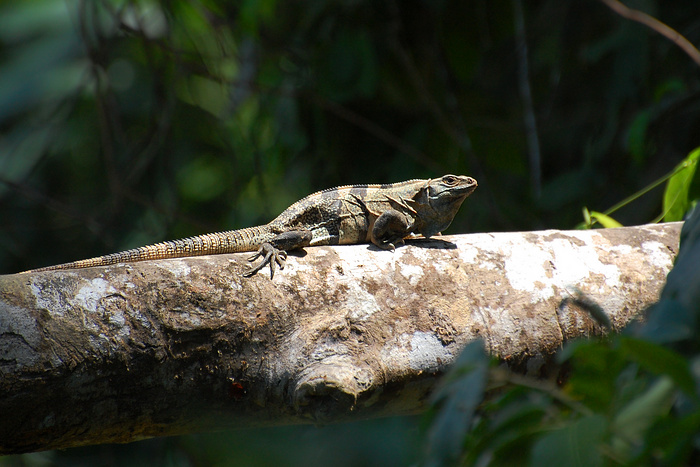
1680x1050 wallpaper
Nor flowers:
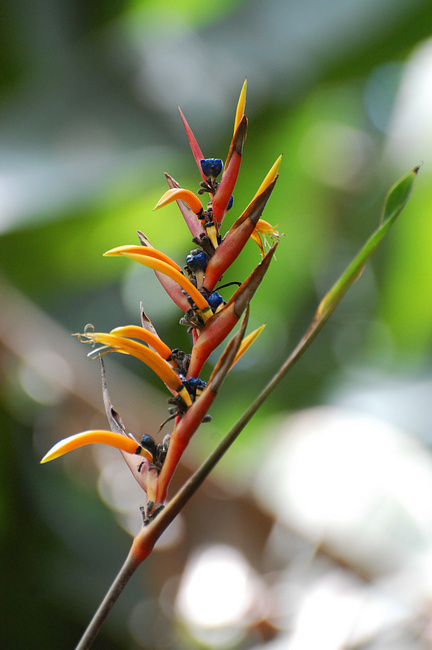
Familiar Turkey Vultures and Black Vultures were ubiquitous in Costa Rica (even on the beach!), but I saw only two King Vultures, both thanks to Johan. The first, my lifer, was in Esquipulas, and was too far away for even a bad picture. Johan spotted this one soaring soon after we came out into the open at the lagoon.
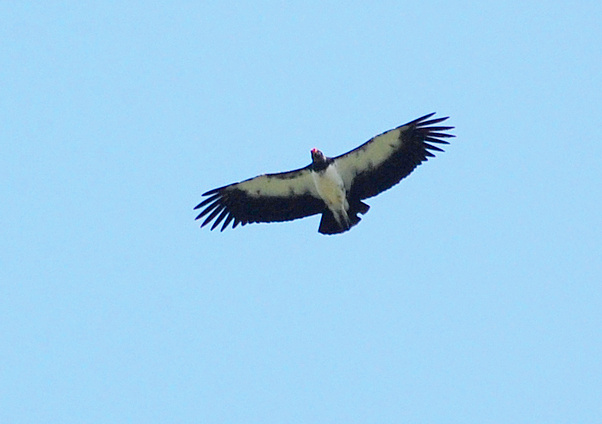
Here's what a King Vulture looks like up close. It's said they're called kings because when they descend to a carcass, other vultures make way. You can kinda see why.
Late in the day, Johan took us to a small creek which is known as a favorite evening bathing spot for a variety of birds, and we stayed there until sunset. This ended up being not only a high point in the Carara trip, but one of the high points of my whole vacation. Photographing it was difficult. The lighting was poor, and my camera wanted tons of exposure time to compensate; I could not possibly hold it steady enough to expose for that length of time without blur. Of course, disturbing the birds with flash was out of the question. I considered fiddling with the ISO setting, and our guide graciously offered to lend me his tripod, but in the end, I decided to just sit and enjoy.
A Red-Capped Manakin was the first to make an appearance. (Red-Capped Manakins, on account of their particular lek dance routine, are called "Michael Jackson birds." They moonwalk. (No, seriously--if you only ever click on one link in my blog, click on this one. You won't regret it.)) Then another, and another still. While one of them was splashing in the water, a Blue-Crowned Manakin perched right over his head--a visceral "wow" moment for both me and Michael. A Black-and-White Warbler (a wintering bird from North America) made an appearance, followed by a Sulphur-Rumped Flycatcher. A Long-Billed Hermit (at six inches, a comparatively enormous hummingbird) zipped in, dipped his tail, and zipped out. A late arrival was a nondescript brown bird called a Thrushlike Schiffornis, which our guide proclaimed to be the best (i.e. rarest) bird of the trip.
The most my camera (and some digital sharpening) could do:
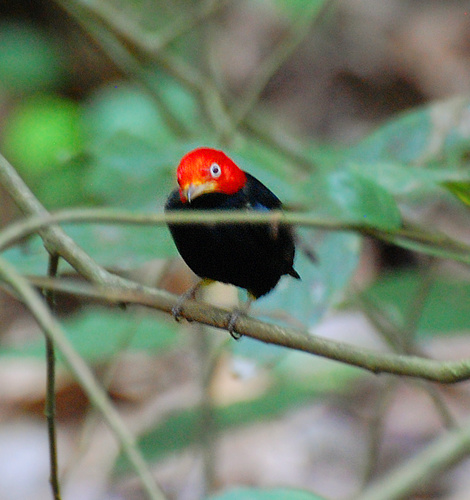
Red-Capped Manakin
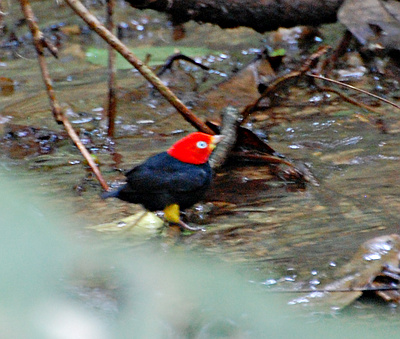
Those things that look like yellow leg warmers are part of the bird. He shows them off when lekking.
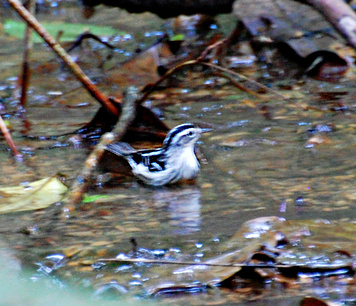
Black-and-White Warbler
When this incredible show was over, alas, Carara was over, and we hurried back down the trail before night set in, accompanied by the lion-like roars of a troop of Howler Monkeys.
Carara National Park (part 3)
May 3rd, 2014
Once we reached the lagoon, I crept along the edge angling for a good photo of the shorebirds and herons. The harsh midday sun made things difficult--as did the wariness of my subjects! This pair of Black-Necked Stilts regarded me sternly, while the young Jacana seemed to wonder what all the fuss was about.
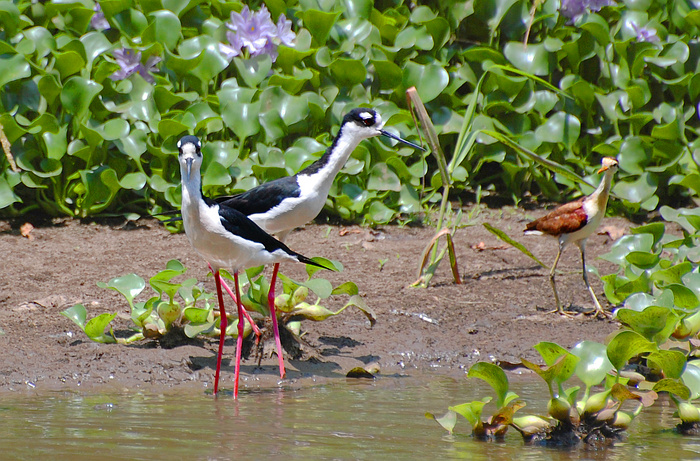
1680x1050 wallpaper

Left to right: Bare-Throated Tiger Heron, Black-Necked Stilts, Tricolored Heron. The young jacana is hiding in here too. Look near a brown leaf to find him.
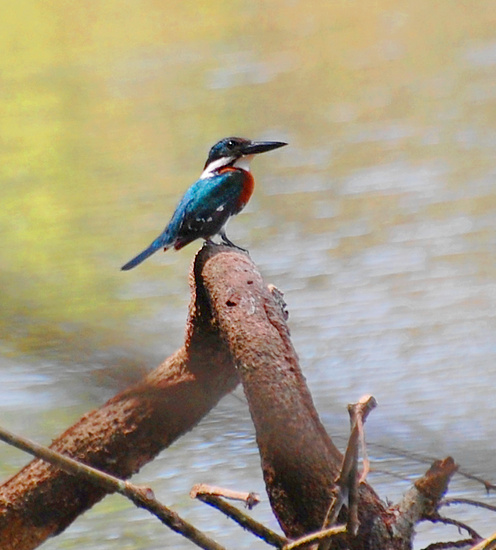
Green Kingfishers were common, as they seemed to be in just about any wetland in Costa Rica. This one looked rather regal in the bright sun.
At the end of the lagoon trail lay a Boat-Billed Heron nesting colony. I'd seen Boat-Billed Herons in my field guide before the trip, and thought they looked a lot like our local Night Herons (to whom they're related.) In person, they looked nothing like Night Herons. They looked like the strangest birds I'd ever seen: like giant-eyed, bulbous-billed muppets. The juveniles were, frankly, ugly, but it was an ugliness you had to love!
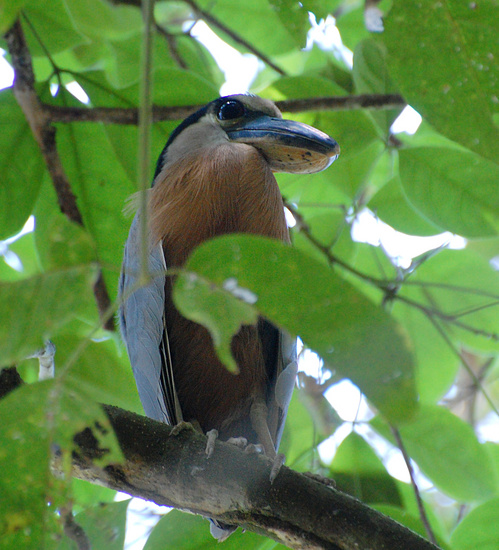
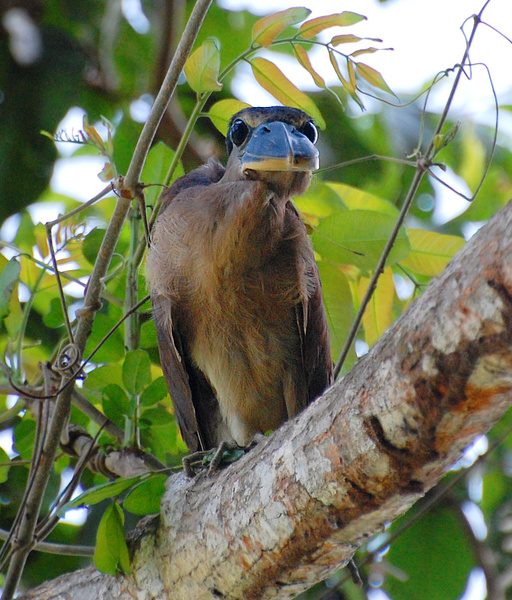
The adults go for a more debonair look, taking on a slightly less bulbous bill and a wavy hairdo.
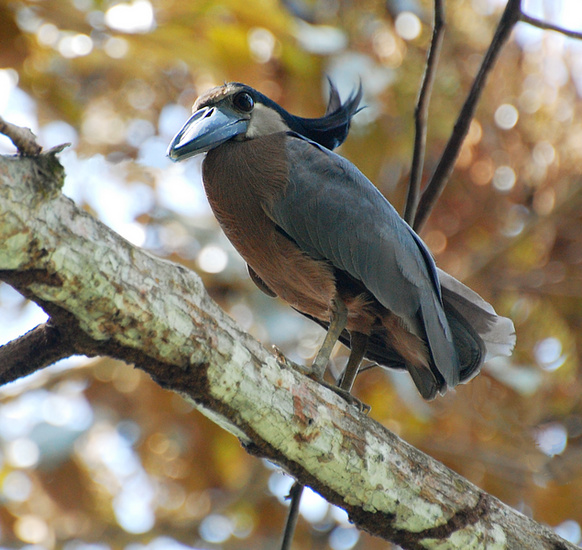
Not a photomanip, I swear to god. They really look like that.
They're nocturnal herons, thus the huge eyes. The bill is an adaptation to their diet and way of feeding. While most herons spear fish using their long, pointed bills, Boat-Billed Herons just scoop them up out of the mud, along with small crustaceans and aquatic insects.
(Continued in next post)
Carara National Park (part 2)
May 1st, 2014
There are a lot of showy birds in the rainforest. But the showiness of the Royal Flycatcher is sneaky: an exuberant multicolored peacock crest that stays hidden 99% of the time, folded up like an Asian fan into the back of the head.
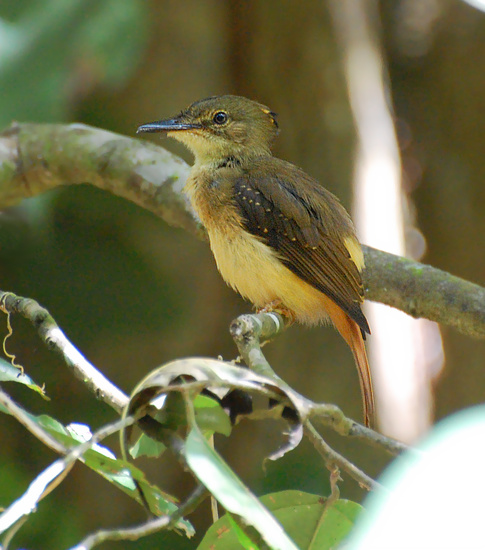
When it does unfurl, it's very much a blink-or-you-miss-it affair. The easiest way to get a good look is like this: take the bird in hand. Apparently, as discovered by bird banders and researchers, the experience of being held is startling enough to provoke a full-on display. Those of us for whom that is not an option must content ourselves with brief unphotographable glimpses, or with the fraction of the crest that sticks out when the bird preens.
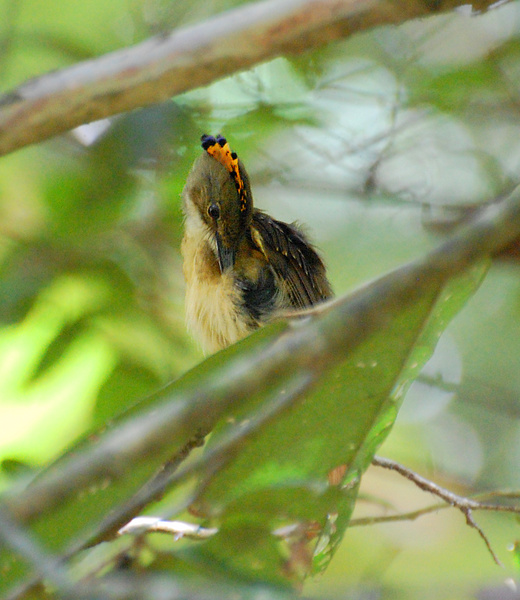
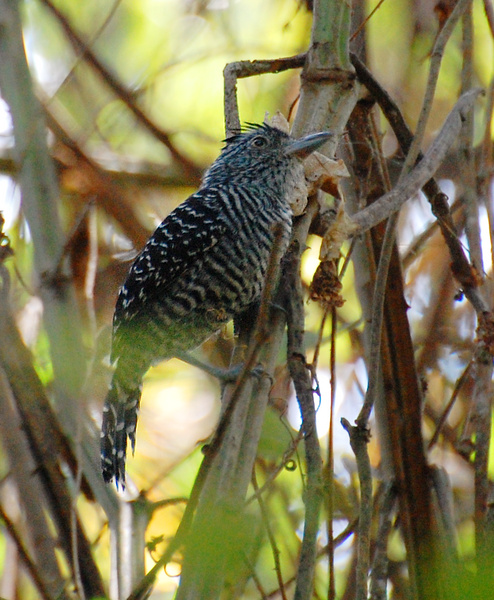
Another of the many army-ant-followers, Barred Antshrike was on my wishlist due to its striking black-and-white plumage. I saw only this one, skulking in a dense thicket. (Like so many of my successful wishlisters, I have Johan's eagle eyes to thank for it.)

I wasn't above photographing the occasional butterfly on a bird-watching tour! This one's a Red Postman, I think.
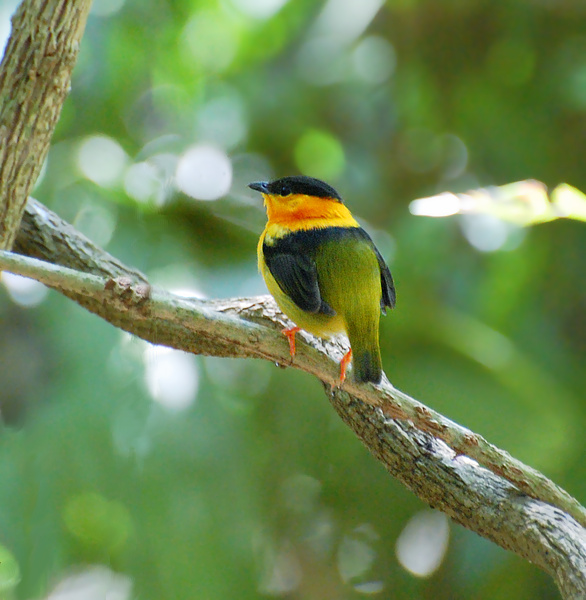
Orange-Collared Manakin
Just can't get enough of him :-)
(Continued in next post)
Carara National Park (part 1)
April 28th, 2014
On Monday, we went on our second tour with Johan Chaves: a full day in Carara National Park, one of the best birding destinations in the country. Vividly colored trogons and toucans, parrots and hummingbirds captured our eye, although comparatively few of these came within reach of my 300mm lens. This guy certainly did though:
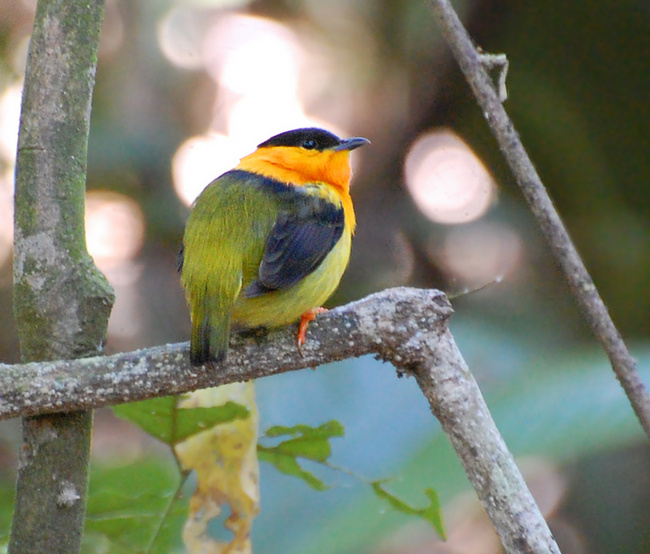
1680x1050 wallpaper
I want to make an aside here, for something I found amusing. I sometimes take my non-birder friends and family out on walks. Some of them are casual nature lovers, or if not, I can coax them in that direction. What they notice mostly is the tame, bold, inquisitive birds, and what they admire mostly is the colorful birds. They notice the adorable chickadees coming to their hands for sunflower seed. They notice the cardinals and blue jays perching in plain view, and the iridescent green of the mallards. I'm usually looking at other things, and if they can even pick out what it is I'm looking at, they might wonder what on earth is so interesting about it.
As a hard-core birder, you see so many cardinals and blue jays and chickadees that you become blase. You start focusing on the elusive birds, the wild ones, the hidden ones, above all, the rare ones. The more you bird, the more "interesting because it's rare" becomes a thing, and "boring because it's common" becomes something you fight against. (Or I fight against it, anyway. Because it's not true. They're all interesting.)
But when a temperate-zone birder visits the tropics for the first time, it's an exercise in role reversal. Now you're the one oohing and aahing over the flashy common birds, while your tour guide, who has seen them all a thousand times before, rolls his eyes discreetly. While you're going ape over toucans and macaws, he's going ape over some drab, nondescript fellow with a drab, nondescript name like Thrushlike Schiffornis or Stub-Tailed Spadebill.
You get it, because you're a birder. You empathize with his fascination with the rarity. You take a good look at the drab rare bird. But then you turn back to the Scarlet Macaws and ooh and aah some more.

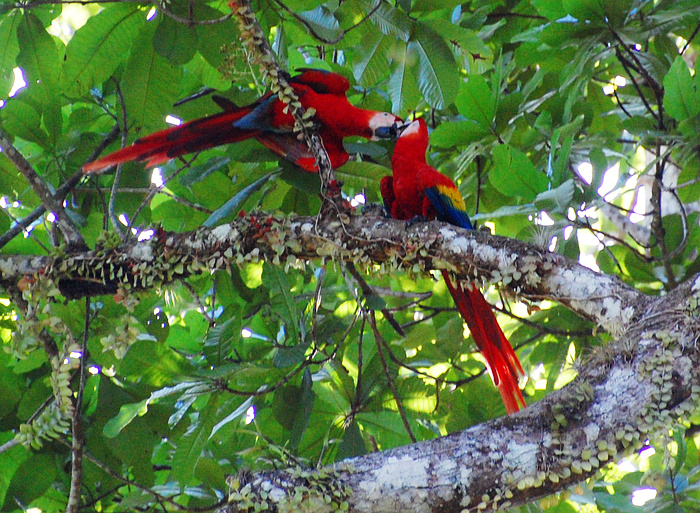
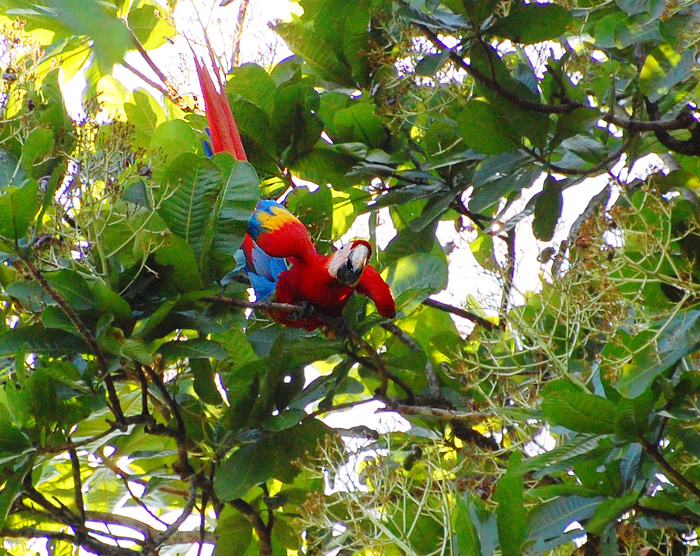
Scarlet Macaws are a highlight in any trip to Carara, one of the few places in Costa Rica where these magnificent parrots--flying rainbows, some call them--are still a common sight. Every morning they come to the park to feed. Every evening their colors streak across the sky as they migrate in pairs and flocks to their roosting grounds in the mangroves. Despite their vivid colors, you usually hear them before you see them. Their squawks carry for miles.
There were many more highlights. Orange-Collared Manakins (pictured at top) were high up on the list. Manakins are lekking birds: the brilliantly-colored males gather at special sites and put on shows for the females, who come, watch, mate if they're sufficiently impressed, and then leave to build nests and raise young alone. Every species of manakin has its own unique dance routine. Johan happened to know of a lek site. Unfortunately no females were around to spur the males on to their full performance (which involves leaping to and fro while snapping their wings like some avian version of click beetles. Have a look.) However, using a recording to convince the lek regulars that a strange male had come along, Johan was able to call one out into close view.
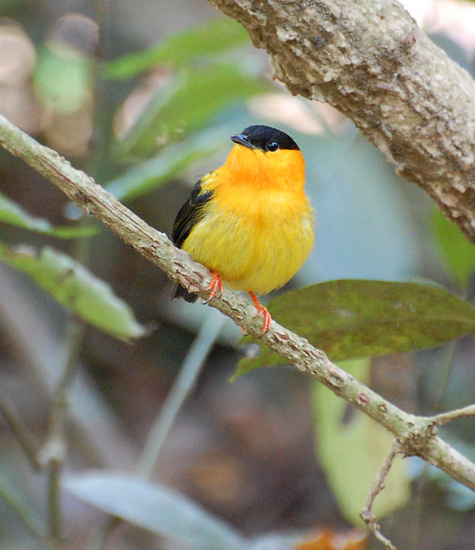
1680x1050 wallpaper
(Continued in next post)
Costa Rica Raptors
April 26th, 2014
Crested Caracara was one of my early lifers, being both common and distinctive enough that it's hard to miss. (You might have seen one yourself if you've ever been to Florida, Texas or Arizona.) Even though this bird is part of the falcon family, it's more of a scavenger than a hunter. Like vultures it has a bare face, and for the same reason: to help it stay clean despite its somewhat unsavory eating habits. When it does hunt, it's as likely to take insects as animals.
One day I even found a Caracara with the Cattle Egrets, foraging in the tractor's wake as they did. I got a good shot of him when he perched beside the road.
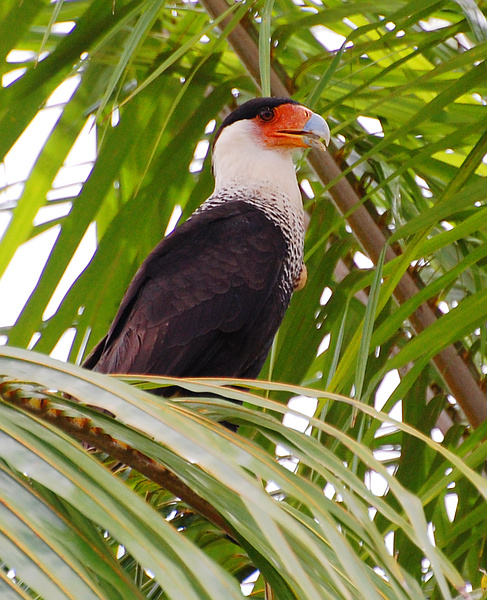
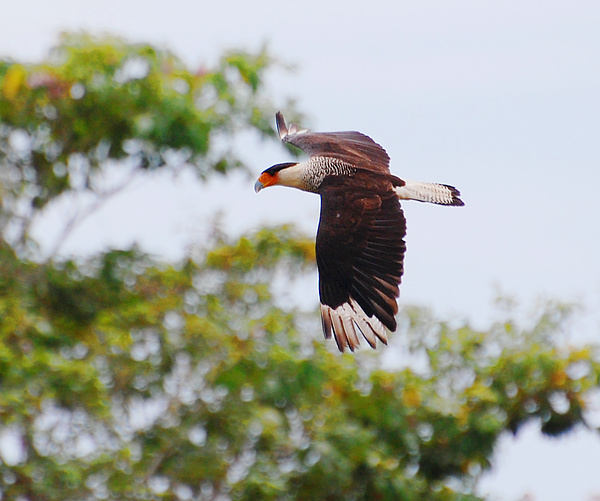
Roadside Hawks occupy a similar niche in the tropics to the one Red-Tailed Hawks occupy here: hunting small mammals at field edges, often close to human settlement. They also take the occasional insect or lizard. This one came down almost to eye level and even did a bit of hunting as I stood there.
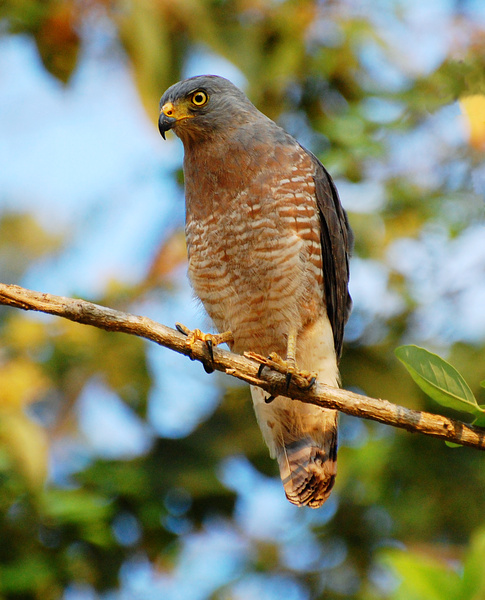
1680x1050 wallpaper
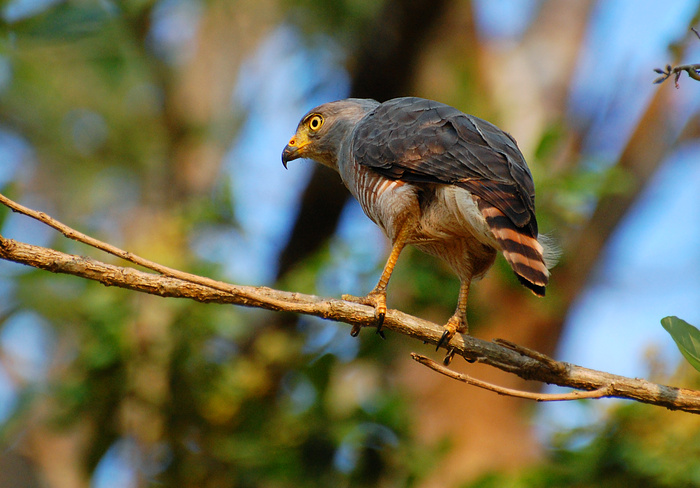
1680x1050 wallpaper
Meanwhile...
April 23rd, 2014
Spring migration is in full swing! I haven't had much chance to post about it what with the flurry of Costa Rica pictures (which isn't over yet--I have a few more around-the-resort birds to share, and then it's on to the avian grand finale of the vacation, our tour to Carara National Park.) But I've been having a great time watching all our breeding birds come home again.
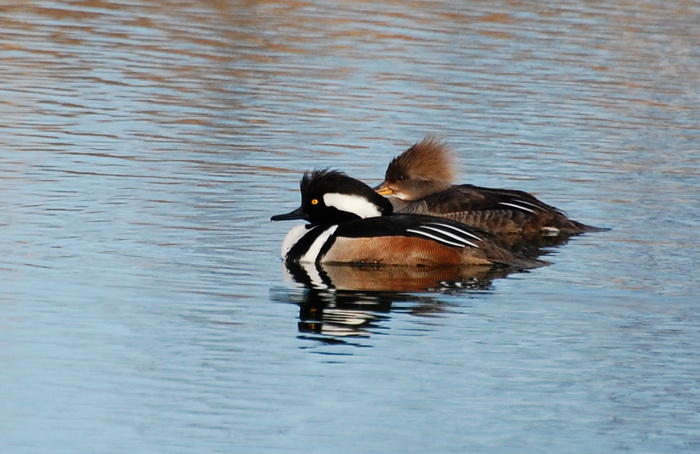
1680x1050 wallpaper
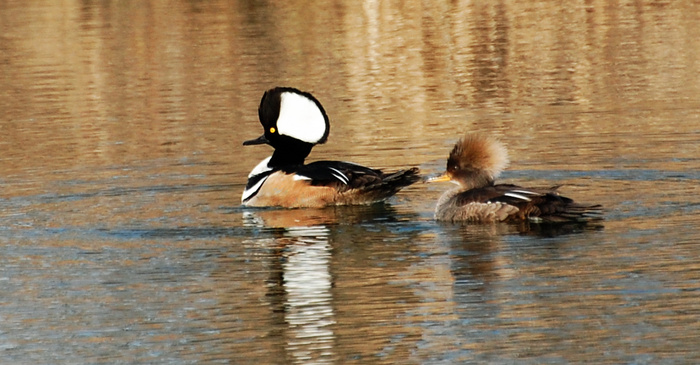
1680x1050 wallpaper
I'm actually cheating with these. They're leftovers from a photo shoot around this time last spring that I didn't develop before. The Hooded Merganser pair is back on the same pond--I saw them yesterday--but there's no real reason to disturb their peace when I already have something to show.
So far it's blackbirds and kinglets, ducks and cranes, and other birds who can handle our often cold and wet April weather. But in another couple weeks, the Yellow Warblers will be back. I can't wait.
Manuel Antonio National Park
April 21st, 2014
On Saturday Michael and I decided on a visit to Manuel Antonio, for some hiking, birding and maybe swimming. I've already shared the star of that trip, the Blue-Crowned Motmot that flew to within ten feet of us. Another happy sighting was a glittering Red-Legged Honeycreeper. On the Esquipulas trip, Mike and Johan had seen one of these while I was separated from them (at the very time when I was getting my lifer Chestnut-Backed Antbird, in fact.) It was gone by the time I got back. So it was nice to see one at last.
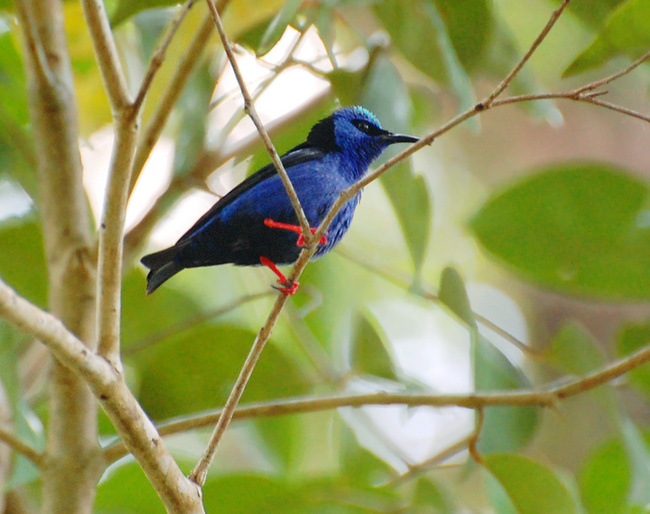
I actually mistook that for a wintering Indigo Bunting at first, despite, y'know, the blazing red legs and long curved bill and pretty much everything other than the fact that it was blue. Not my proudest moment as a birder!
A family group of raccoon-like animals caught our attention, as they travelled along in a dried up stream bed below us. I initially thought they were coatis due to their elongated snouts, but some research cleared things up. Turns out they're Crab-Eating Raccoons--aptly named close cousins of the raccoons we all know and love. They were hard to photograph in the shadows and brush, but this one briefly came out in the open.

The odd-looking guy below is a Common Basilisk, although the locals would call him a Jesus Christ Lizard. Here's why.
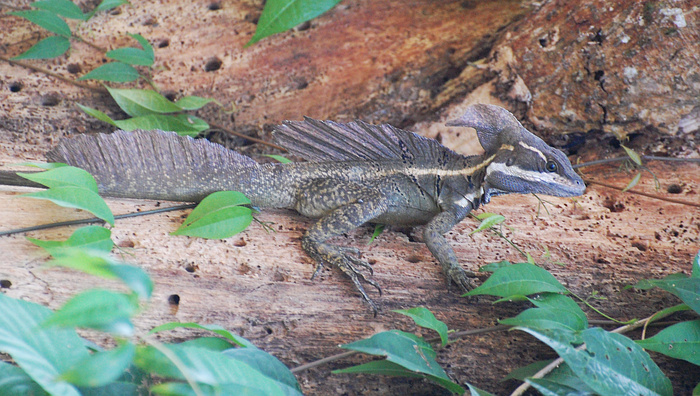
Our final sighting of the day came late and unexpectedly. Our taxi driver was taking us back to the resort when he pulled over suddenly, exclaimed that there was a toucan in a tree and let us out to see it. Thus did I get my lifer Chestnut-Mandibled Toucan! (Handsome tip: earned.) It was distant and half-obscured by foliage, but still pretty exciting considering. As Mike said afterwards, "everyone in Costa Rica is a tour guide!"
Seedeater Birdscapes
April 20th, 2014
The seedeaters, as a group, stole my heart in Costa Rica. No, they're not colorful or beautiful singers or anything like that, just very small and shy and cute. They seemed to me as tiny as hummingbirds. The sapling palms near our resort were dripping with them.
A close-up was out of the question. As soon as I approached within a certain distance, every last one of them would melt into the scenery. I had to make do with "birdscapes." I especially liked the view of these female Yellow-Bellied Seedeaters with the mountains silhouetted in the distance.

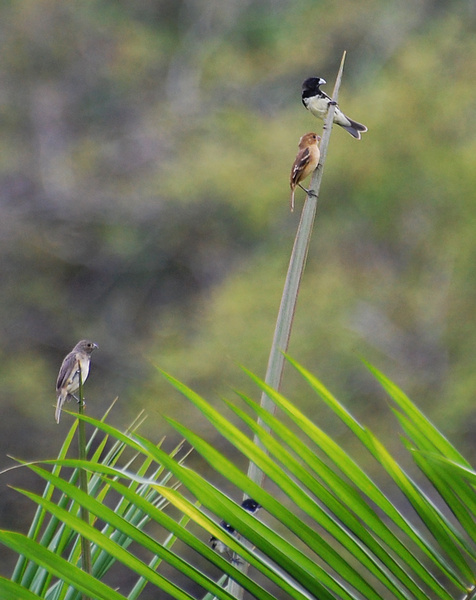
Top to bottom: male Yellow-Bellied Seedeater, female White-Collared Seedeater, juvenile male Yellow-Bellied Seedeater, male White-Collared Seedeater. (Yes, there's a fourth one hiding down there.) Yellow-Bellied Seedeaters roam widely in search of seeding grasses, and apparently that's the only reason I saw them. They're not normally found in Quepos. Johan Chaves went searching for them after I left, but the flock had already moved on.
Equally tiny Blue-Black Grassquits shared the same habitat. These guys were quite pretty when the light caught them and revealed their cobalt-blue iridescence. They were also more amenable to close-ups.

Many scientists believe that Blue-Black Grassquits were the original parent species of Darwin's finches--the birds that helped Charles Darwin develop his theory of evolution. When they first spread to Galapagos the islands were nearly birdless. So they proceeded to rapidly diversify into about fifteen different species, each one exploiting a previously empty niche.
A pair of Mangrove Black Hawks was nesting in a big dead tree near the estuary. These hawks' favorite food is crabs, sometimes captured by racing after them on foot through the mud! To everyone other than crabs, they seemed to hold the status of "gentle giant"--the little seedeaters would perch in the same tree as them without any sign of fear. The hawks also tolerated me close to their nesting tree, although the first time I walked by on any given day, one of them would usually do a quick fly-by to check me out (or maybe dissuade me from trying any funny business?) This made for a good photo op if I had my camera at the ready.
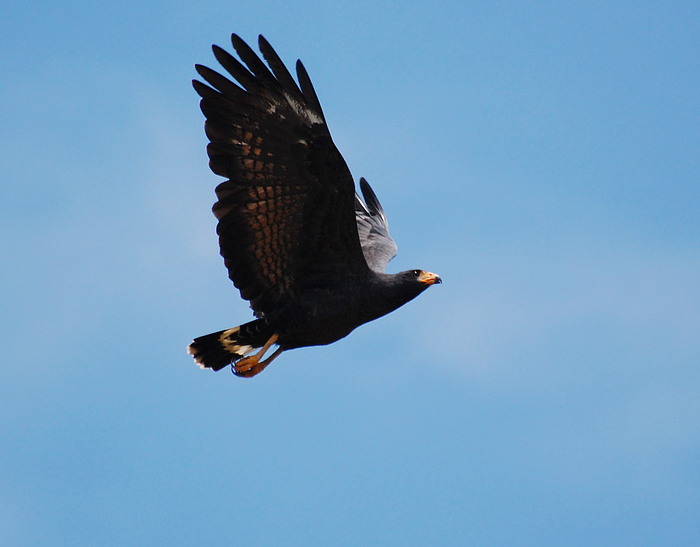
1680x1050 wallpaper
Wherein Ursula Vernon makes me laugh hysterically
April 17th, 2014
Birder Directions: A Play In One Act
El Rey wetlands with Johan Chaves
April 16th, 2014
In the dry season, El Rey was shallow marsh, productive of wading birds like gallinules and herons, plus the occasional kingfisher. (In the wet season the adjacent fields flood and breeding waterfowl move in.) One of the high points for me was a tiny American Pygmy Kingfisher. This guy is less than half the size of the kingfisher we're familiar with in North America (Belted), and eats very small fish and aquatic insects.

Familiar Green Herons were everywhere in Costa Rica, anywhere they could find the tiniest bit of water to fish in. This time of year the resident Green Herons were joined by wintering birds from North America. Like so many of the wintering birds, they seemed tamer than back home.

1680x1050 wallpaper
The beautiful adult Purple Gallinules eluded my camera. I saw them only in brief glimpses. But this juvenile was a lot more willing to come out in the open--perhaps because his camouflage was better! Typical of his species, he stayed expertly out of the water by scrambling over aquatic plants.
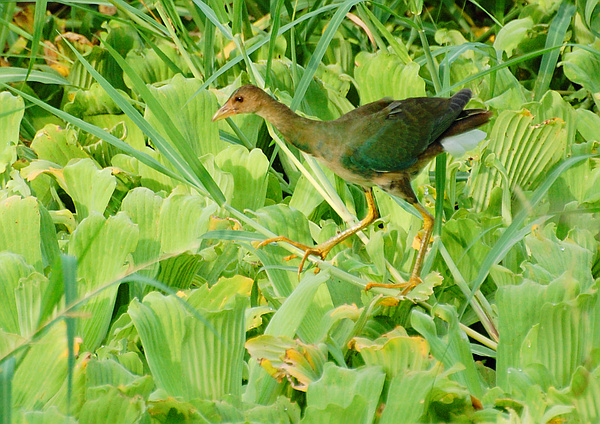
As did the jacanas. You can see below the ultra-long toes that allow jacanas to even balance on floating lily pads.
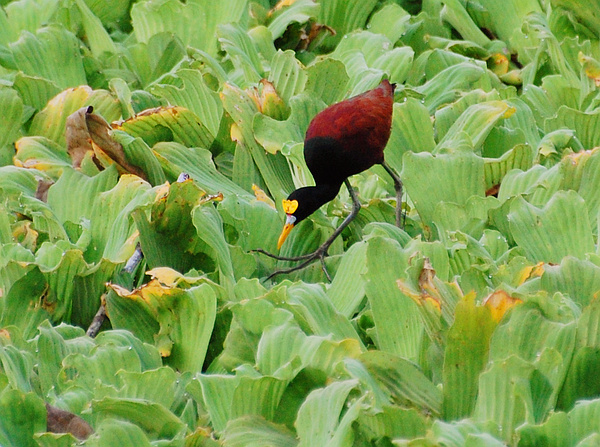
|
